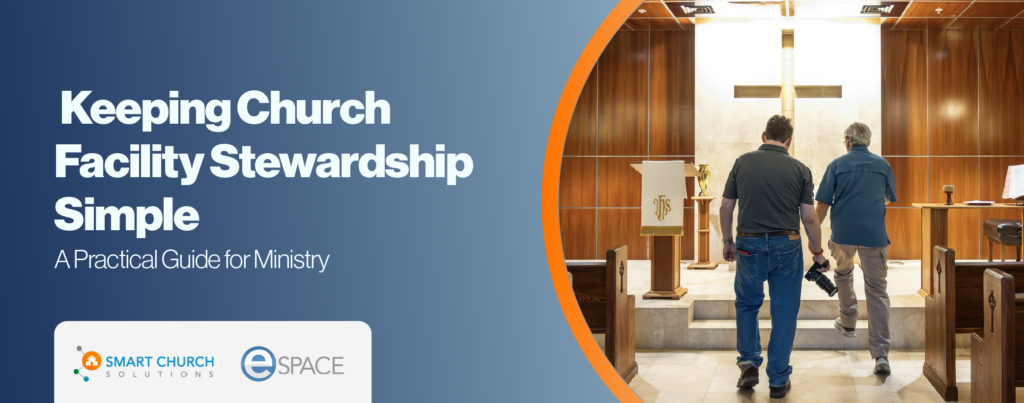Have you ever been part of a conversation with seasoned experts in their field, and you felt like they were speaking a foreign language? We see this a lot in the world of facility management and stewardship, especially for those new to this sector of the church world. Or for those with limited exposure, the terms that get tossed around by contractors, vendors, warranty manuals, blueprints, trade magazines, and textbooks can be confusing.
We feel your pain!
To that end, we have compiled a very detailed glossary of facility management terms. For some of you, this is going to feel silly and elementary. However, this will prove a useful tool to use as a reference guide for the rest of us.
Fair warning: This is a huge list, so do not let it overwhelm you. Take it word-by-word.
A
A.C.: Alternating current.
AAR: Air-to-air recovery system.
AASHE: Association for the Advancement of Sustainability in Higher Education.
ABATEMENT: A complete or partial cancellation of a levy imposed by a governmental unit. Abatements usually apply to tax levy, special assessment, and service charges.
ACCOUNTING PROCEDURE: The arrangement of all processes that discover, record, and summarize financial information to produce financial statements and reports as well as to provide internal control.
ACCOUNTS RECEIVABLE: Amount owed an open account from private persons, firms, or corporations for goods and services furnished by an organization.
ACCRETION: The buildup of land along a beach or shore by deposits of waterborne or airborne sand, sediment, or other material.
ACCRUAL BASIS: The basis of accounting under which all items are recorded when incurred. Revenues are recorded when earned and expenditures are recorded as soon as they result in liabilities even though the actual receipt of the revenue or payment of the expenditure may take place, in whole or in part, in another accounting period.
ACIDIFICATION: One of the types of degradation to the soil that can take place as a result of environmental pollution, along with contamination, desertification, or erosion.
ACM: Asbestos Containing Material.
ACQUISITION ADJUSTMENT: Premium paid for a physical asset over and above original cost less depreciation.
ADA: Americans with Disabilities Act, requiring public and private sector organizations to adhere to certain standards intended to remove barriers for persons with various types of disabilities.
ADAPTATION/RENOVATION/MODERNIZATION: The improvement, addition, or expansion of facilities by work performed to change the interior alignment of space or the physical characteristics of an existing facility so it can be used more effectively, be adapted for new use, or comply with existing codes. Includes the total expenditures required to meet evolving technological, programmatic, or regulatory demands.
ADEQUATE FACILITY/STRUCTURE/SPACE: A facility, structure, or space that is fully capable of supporting its current use without modification or repairs (beyond currently funded routine maintenance) and has an acceptable level of reliability.
ADJUSTMENT FACTOR: A method by which a weekly multiplier is determined. For example, if a task is required to be accomplished once per week, it is assigned an adjustment factor of 1.00. If the task is altered to be accomplished every other week or biweekly, then the factor becomes 0.50.
AERATE The process of making holes or slits in turf to improve or alter the physical soil conditions and to stimulate plant growth. Aeration increases air infiltration, water percolation, and plant nutrient mobility into the root zones. A cultural practice used to correct soil compaction.
AERIAL LIFT: Hydraulically operated aerial tower used for ascent and tree entry, usually mounted on a large truck. Line crews use some as short as 35 feet for clearing cables and streetlights. Most forestry departments use towers of 45 to 55 feet for trimming and removal operations. Sometimes used to replace burned-out floodlights at ballparks. Also known as a cherry picker.
AEROSOL: A fine spray produced by pressurized gas that leaves very small droplets of solids or liquids suspended in the air.
AGING OF RECEIVABLES: An analysis of individual accounts receivable according to the time elapsed after the billing or due date: usually the former.
AGREEMENT: (1) A legally enforceable promise or promises between two or among several persons. (2) On a construction project, the document stating the essential terms of the construction contract that incorporates by reference the other contract documents. (3) The document setting forth the terms of the contract between the architect and owner or between the architect and consultant.
AIA: American Institute of Architects, a professional organization for architects.
ALH: Annual labor hours.
ALLOCATE: To divide a lump sum into parts that are designated for expenditure by a specific organizational unit and/or for specific purposes, activities, or objects.
ALTERATIONS: Work required to adjust interior arrangements or other physical characteristics of an existing facility/structure so that it may be adapted to, or utilized for, a new or changed use. Includes renovating a facility to meet modern standards.
AMENDMENT: A chemical or mineral element added to the soil to improve soil characteristics, such as porosity, aeration, drainage, pH, and moisture retention.
AMERICANS WITH DISABILITIES ACT (ADA): An act signed into U.S. law on July 26, 1990, that prohibits discrimination on the basis of disability with regard to employment, programs, and services provided by state and local governments; goods and services provided by private companies; and in commercial facilities. The ADA contains requirements for new construction, for alterations or renovations to buildings and facilities, for improved access to existing facilities of private companies that provide goods or services to the public, and for state and local governments to provide access to programs offered to the public. The ADA also covers effective communication with people who have disabilities, establishes eligibility criteria that may restrict or prevent access, and requires reasonable modifications of policies and practices that may be discriminatory.
AMORTIZATION: The gradual reduction, redemption, or liquidation of the balance of an account according to a specified schedule of times and amounts.
ANNUAL FLOWERS: Herbaceous plants that live one year or less, during which time they grow, flower, produce seed, and die.
ANNUALS: Herbaceous plants characterized by abundant flowering that live for one year or less, during which time they grow, flower, produce seed, and die.
ANNUITY AGREEMENT: An agreement whereby money or other property is made available to an institution or individual on the condition that the institution bind itself to pay stipulated amounts periodically to the donor or other designated individuals. The payments are to terminate at a time specified in the agreement.
ANSI: American National Standards Institute.
APPRAISE: To make an estimate of value, particularly of the value of property.
APPROPRIATION: An expenditure authorization with specific limitations as to amount, purpose, and time; a formal advance approval of an expenditure from designated resources that are available or estimated to be available.
APPROVED EQUAL: Material, equipment, or method approved by the client for use by the contractor as being acceptable as an equivalent in essential attributes to the material, equipment, or method specified in the contract documents.
ARBOR: A light, open structure of trees, shrubs, or vines closely planted, twined together in a self-supporting manner or supported on a light, latticework frame.
ARBORETUM: A place where trees and related plants are grown for the purposes of education, research, or display.
ARBORIST: A position that provides expertise in the field of tree maintenance practices, including but not limited to pruning, planting, pest and disease diagnosis, and fertilization. Typically, this position functions as a working lead or supervisor of a tree crew or as the tree specialist for an organization. This position generally requires a moderate to extensive education, experience, and certification in the field of arboriculture.
AS-BUILTS: A set of line drawings, typically prepared by a construction contractor, indicating the precise location of building components and systems.
ASHRAE: American Society of Heating, Refrigerating, and Air-Conditioning Engineers. Now known only by acronym.
ASME: American Society of Mechanical Engineers.
ASPHALT: (1) A dark brown to black cementitious material, solid or semisolid, in which the predominating constituents are bitumens that occur in nature. (2) A similar material obtained artificially in reining petroleum, used in built-up roofing systems as a waterproofing agent. (3) A mixture of such substances with an aggregate for use in paving.
ASPHALTIC CONCRETE: Paving, Blacktop, A mixture of asphalt and graded aggregate widely used as paving material over a prepared base; it is normally placed, shaped, and compacted while hot but can be mixed and placed without heat.
ASSIGNABLE SQUARE FEET: Measurement of an area that may be occupied and is acceptable for a designated purpose or function. Does not include walls, stairways, corridors, restrooms, parking facilities, or mechanical space.
AST: Aboveground Storage Tank (typically holds heating oil, gasoline, or diesel on a campus).
AUDIT: Examination of documents, records, reports, systems, or internal control, accounting, and financial procedures, and other evidence to ascertain whether financial information is presented fairly in its entirety.
B
BALANCE SHEET: A historical summary for a given economic entity of the assets, liabilities, and owner’s equity (or fund balance).
BALANCED FERTILIZER: A balanced-ratio fertilizer that contains equal amounts of the primary elements nitrogen, phosphorus, and potassium.
BALLED AND BURLAPPED (B&B): Plants prepared for transplanting by digging them so that the soil immediately around the roots remains undisturbed. The ball of earth is then bound up in burlap or similar mesh fabric.
BANKED TURF: A turf area that occurs on a slope considered too steep to mow with standard mowing equipment.
BAS: Building Automation Systems.
BASE MAP: A map indicating the significant existing features of an area—such as the streets, rivers, parks, and rail lines—that serves as the foundation for subsequent mapping and planning.
BENCHMARK: A relatively permanent object, natural or artificial, bearing a marked point with an elevation that is known above or below an adopted datum. Usually designated as a BM, such a mark is sometimes further qualified as a permanent benchmark (PBM) or a temporary benchmark (TBM). Benchmarks serve as references for topographical surveys and tidal observations.
BENCHMARKING: The process of measuring activities considered critical to an organization’s success.
BEQUEST: Property or funds received through a will. Restrictions may or may not attach to use of the property or funds.
BERM: A mound of earth, with a length greater than its width, constructed as a barrier or an aesthetic landform.
BID: A complete and properly signed proposal to do the work or designated portion thereof for the sums stipulated therein, supported with data called for by the bidding requirements.
BID BOND: A form of bid security executed by the bidder as principal and by a surety. See also Bid Security.
BID DATE: The date established by the client for the receipt of bids.
BID FORM: A form furnished to a bidder to be filled out, signed, and submitted as the bid.
BID SECURITY: The deposit of cash, certified check, cashier’s check, bank draft, money order, or bid bond submitted with a bid and serving to guarantee to the owner that the bidder, if awarded the contract, will execute the contract in accordance with the bidding requirements and the contract documents.
BIDDER: One who submits a bid for a prime contract with the owner; distinct from a subbidder who submits a bid to a prime bidder. Technically, a bidder is not a contractor on a specific project until a contract exists between the bidder and the owner.
BIDDING DOCUMENT: The advertisement or invitation to bid, instructions to bidder, the bid form, and the proposed contract documents, including any addenda issued before receipt of bids.
BIENNIALS: Herbaceous plants that produce leafy growth, often in a rosette, from seed the first growing season, followed by dormancy during the winter months. The second season, the plants develop stalks with flowers and seeds, then die. Typically, biennials live more than 12 months but less than 36 months.
BILL OF LADING: A document issued by a carrier to a shipper, acknowledging that specified goods have been received on board as cargo for conveyance to a named place for delivery to the consignee who is usually identified. May not be used for hazardous or universal wastes.
BOND: A written promise to pay a specified sum of money, called the face value or principal amount, at a specified date or dates in the future, called the maturity dates, together with periodic interest at a specified rate.
BOND DISCOUNT: The excess of the face value of a bond over the price for which it is acquired or sold.
BOOK VALUE (of assets): The purchase price of an asset less any accumulated depreciation. In the case of an asset received as a gift, it is the appraised market value of the asset as of the date donated less any accumulated depreciation.
BRI: Building Related Illness.
BRITISH THERMAL UNIT (BTU): Identifying the amount of energy required to raise the temperature of one pound of liquid by one degree Fahrenheit.
BROADLEAF PLANTS: Plants with leaves in which the veins are almost never parallel. These plants tend to have wider leaves than grasslike plants such as lilies, irises, palms, and orchids. Typically, these plants are dicotyledons (dicots).
BRUSH CONTROL: Control of woody plants and brush, usually by herbicides, weed killers, or mechanical methods.
BTU: See British Thermal Unit.
BUDGET: A plan of proposed expenditures for a fixed period or for a specific project or program along with the proposed means of financing the expenditures.
BUILDING COMMISSIONING: A documented and systematic oversight process of ensuring that the owner’s functional needs are met, through the creation of a design intent agreement, review of construction documents, and verification through testing that all structural, mechanical, electrical, control, and environmental subsystems of a building are installed and will operate as designed.
BUILDING CORE AND SERVICE AREA: The floor area of a facility that is necessary for the operation of the facility and is not available for general occupancy. May include building lobbies, mechanical rooms, electrical rooms, telephone/communications/ server rooms, restrooms, custodial rooms, loading docks, and utility tunnels that are not used for any other purpose.
BURIED TANK: A tank that is either fully or partially buried (at least 10%) and contains only fuel oil that is used for heating on the premises. The tank may have no other purpose.
The Rest
Looking for C-Z? Download our entire glossary to see the remaining terms. We hope this tool helps you become a well-seasoned facility management professional. Onward!








